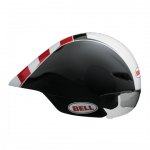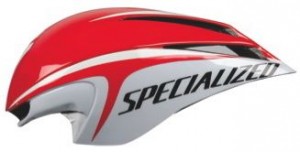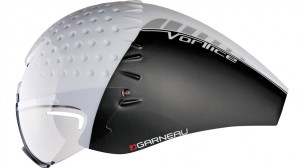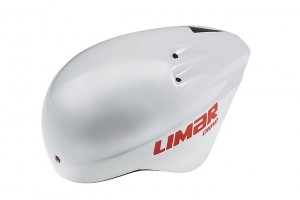Aero Helmet Buyer's Guide
(Originally Published in the Triathlete Magazine 2012 Buyer's Guide)
Features/Considerations: More triathlon specific than its cousin the Giro Selector, the Bell Javelin offers front ventilation, an uncovered tail piece and a lower price. “SeamFlex” ear pieces are comfortable and flexible making for easy on/off and the adjustable “ErgoDial” adjuster works well at securing the helmet comfortably. The deep visor is not particularly easy to remove, but offers very good eye coverage. The moderate length of the Javelin gives it versatility around a variety of back shapes and the design is well balanced between ventilation and aerodynamics. Three sizes – S, M, L. 455g w/visor. 430g w/out.
Features/Considerations: The more TT based relative of the Bell Javelin is focused on maximizing aerodynamics. The Selector does not have any front ventilation, but does have deep internal air channels for air circulation and offers a changeable lower fairing behind the head so that the rider can “select” the right shape for their back and needs. Our unit came with the deep full coverage lower fairing which offered the most head and ear coverage of any helmet being reviewed. The significant coverage combined with the spring loaded RocLoc TT system resulted in the Selector being slightly more complicated than average to put on and take off. S/M or M/L. 390 grams without optional smoke visor (clear is also available).
Features/Considerations: By far the longest profile of any helmet reviewed, the Specialized TT2 looks like the head of the creature in the movie “Alien” and thus is the winner of the “Makes You Look Like a Bad Ass” award. The TT2 also offers a huge front vent and copious rear venting to keep the rider’s head cool and at 420g is surprisingly light and comfortable for its size. Being so deep, the TT2 works ideally when you are headed straight into the wind or in calm conditions. The depth also favors a rider who has a relatively flat back profile and the ability to hold their head stable. XS/S and M/L.
Features/Considerations: Well known aerodynamic consultant John Cobb designed the Wingspan with two things in mind: versatility and aerodynamics. The result is a shorter than average aero helmet that is designed to work well with just about all back shapes and wind yaw angles. The front vent also follows this versatility path as it can be run open, with a mesh cover or closed, depending on whether you want more ventilation or more aerodynamics. The helmet includes a removable tail cover and has large rear vents. Despite the “one size fits all” sizing, the Wingspan was one of the more comfortable and better fitting helmets of the bunch and, at 330g, it tied the Limar for lightest. The Rudy is a hard helmet to go wrong with for many triathletes.
Features/Considerations: The combination of dimples and the unique “Vortex Generator” blades on the front half of the Vorttice stand out visually. Both are designed to create a thin and active boundary layer of air on the surface of the helmet and encourage smooth/laminar airflow around the head. Louis Garneau says that the moderate sized vent at the front of the helmet was strategically placed to minimize drag while maximizing air flow through the three tunneled “Evacuation Channel” that permeates the interior of the helmet. The Spiderlock SL fit adjuster is easy to use and the vented removable visor slides and the nosepiece secures it in the up position. The moderate length and shape of the Vorttice lends itself to a variety of back shapes and the sizing on the helmet feels generous. Available in S, M and L. 540g including the visor.
Feartures/Considerations: Unlike most aero helmets, the Limar Crono takes a minimalist approach and looks and feels the most like a standard road helmet. The Crono sits high on the head and has tall earpieces. It does not have any frontal venting, but does have shallow internal channels to help keep air circulating. The Crono is light because of its smaller size and less aggressive shape and the well thought out dial adjuster behind the head fit and operated well. While riders with significantly larger or smaller than average craniums should try it on, the Crono’s “one size fits most” approach actually works surprising well, covering a broad range of head sizes comfortably. 330g.
Ian Buchanan is co-owner of Fit Werx and a founding member of Master Bike Fitters Association (MBFA). Fit Werx has locations in Waitsfield, VT and Peabody, MA and offers cycling and triathlon products, specialty bicycle fitting and analysis services, consultation, and technology research. Fit Werx can be reached in VT at (802)496-7570, in MA at (978)532-7348 or through the Web at www.fitwerx.com.






